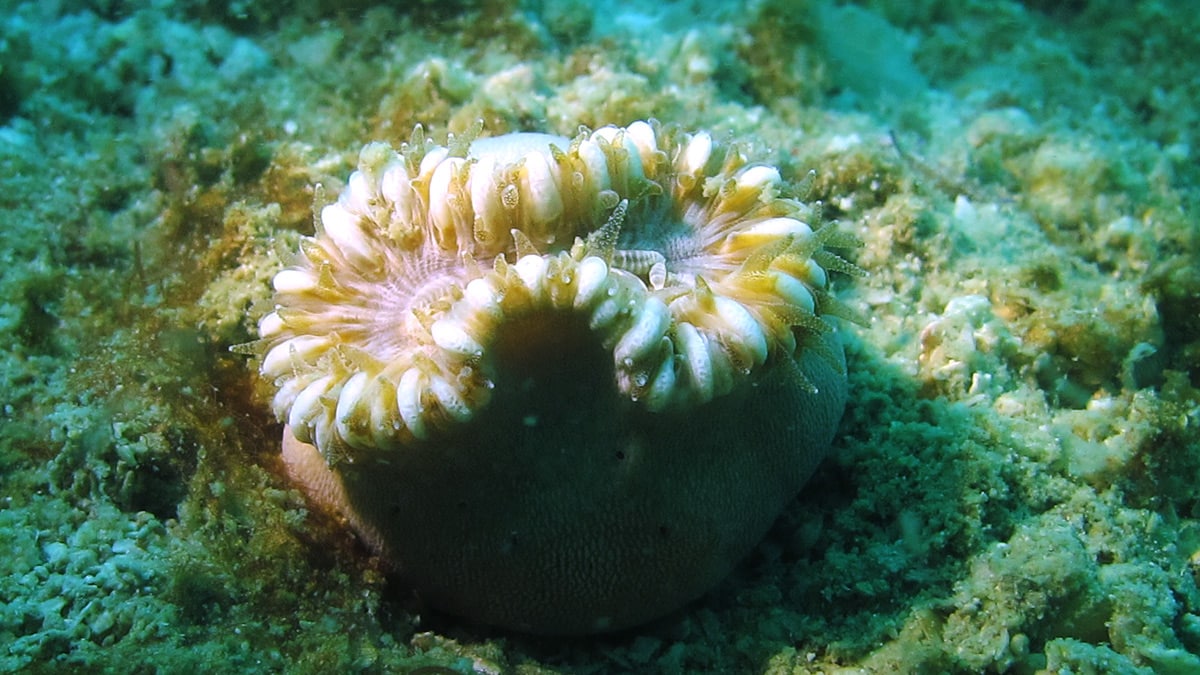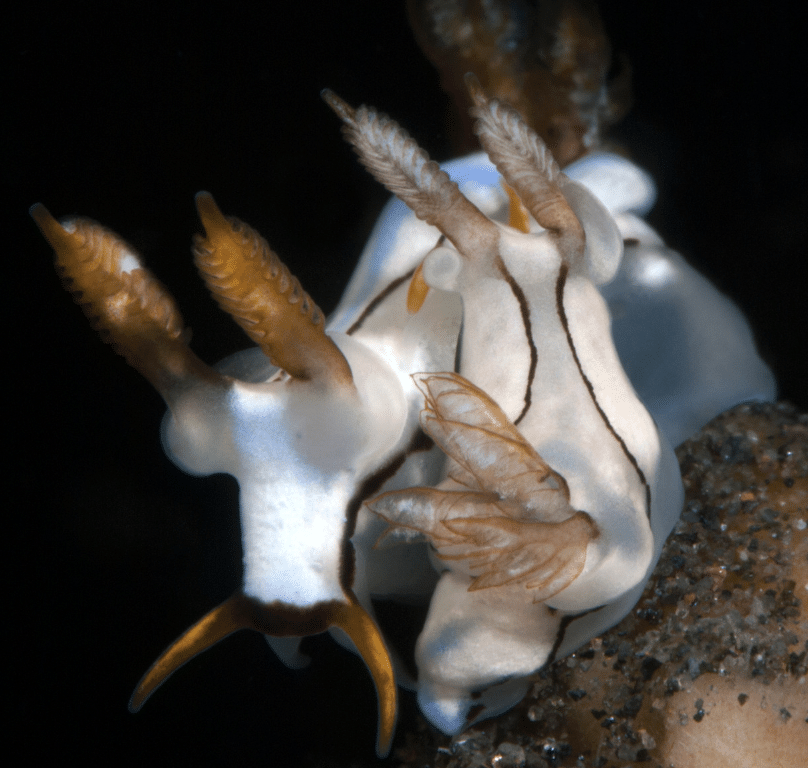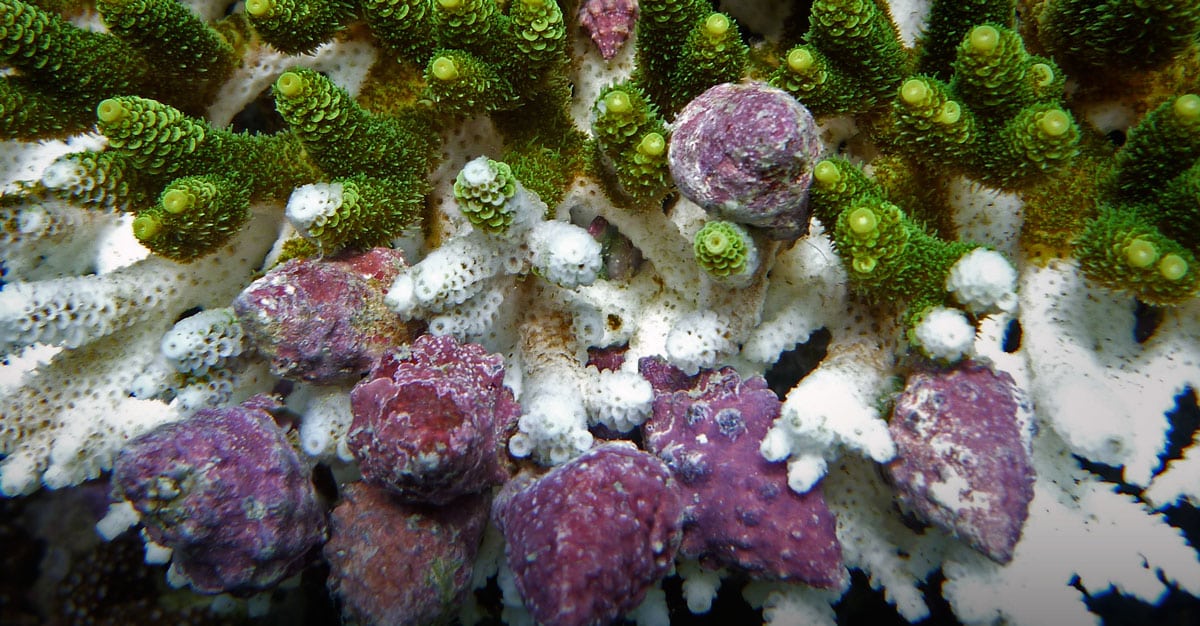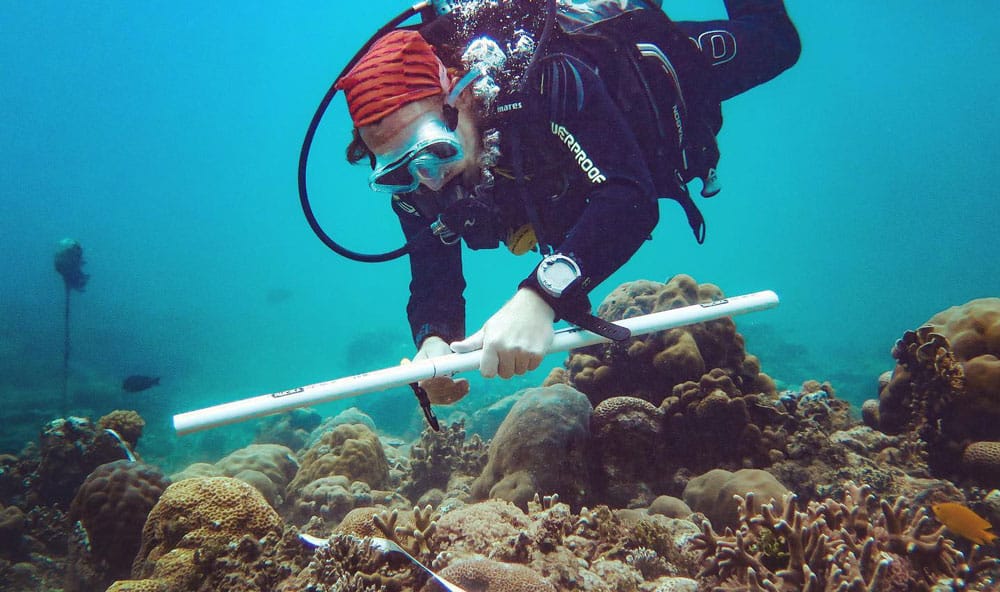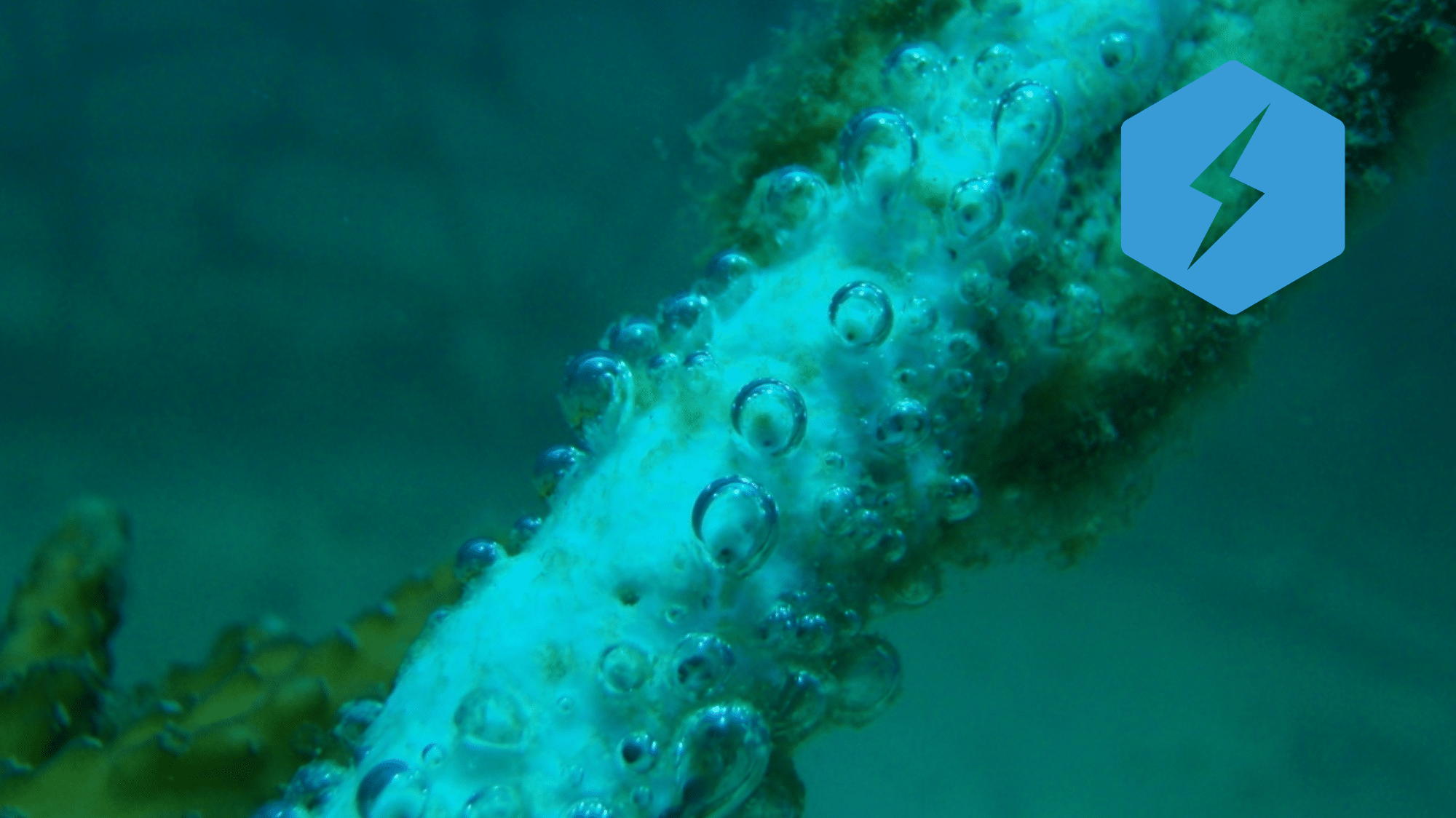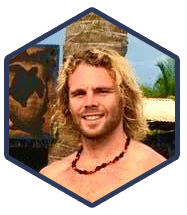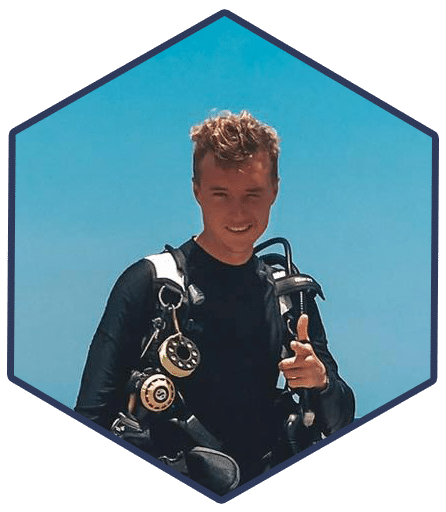An Update on an Itinerant Family of Corals: Dendrophylliidae
A recent publication has shed new light on one of the more diverse and exciting families of corals, Dendrophylliidae. A reorganization of the family is underway using new molecular and imaging techniques and is helping to uncover the evolutionary history of its many species.
The title of this article uses the adjective ‘itinerant,’ which is generally not a word you associate with hard corals, who tend not to wander much. But it fits Dendrophylliidae for multiple reasons. For example, its included genus Heteropsammia, also known as the ‘Walking Dendros,’ which lives on the back of worms and cruises around the sands like kids on dirt bikes. Or, the genus Tubastraea, the only Scleractinian to successfully make it from the Pacific to the Atlantic in the last few million years. As we learn more about the systematics and history of this family, we discover more about the path it has taken to become such an exciting group today.
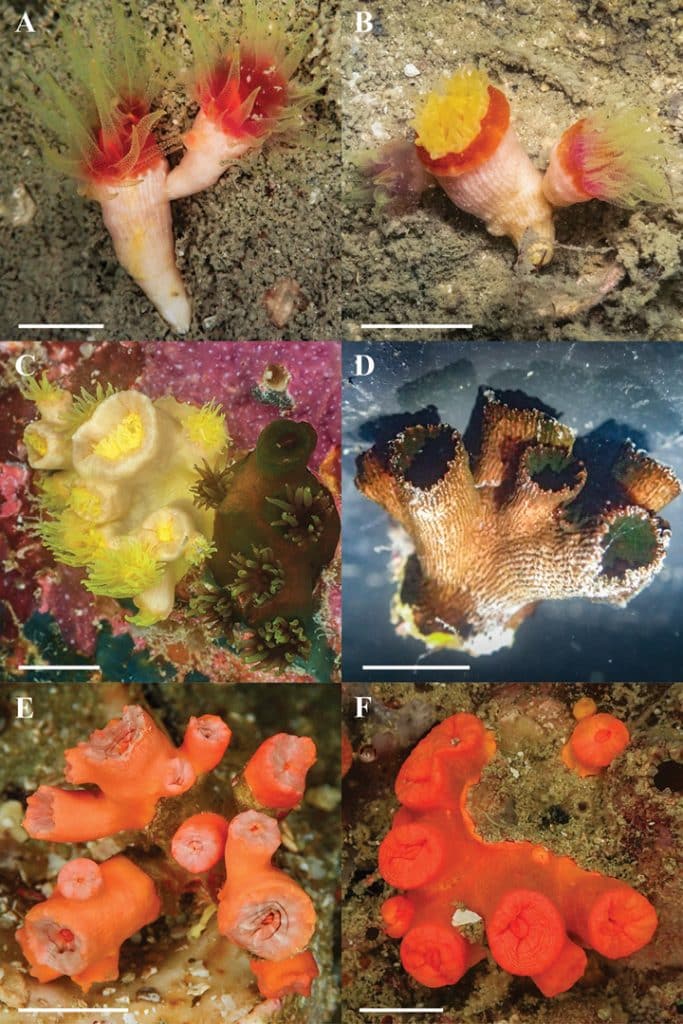
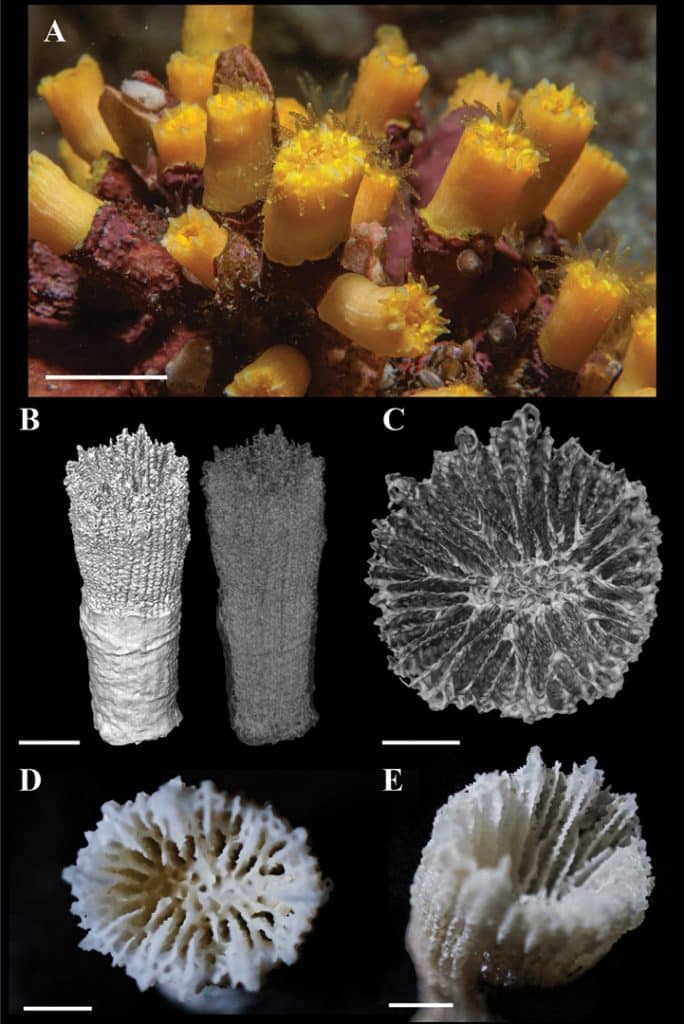
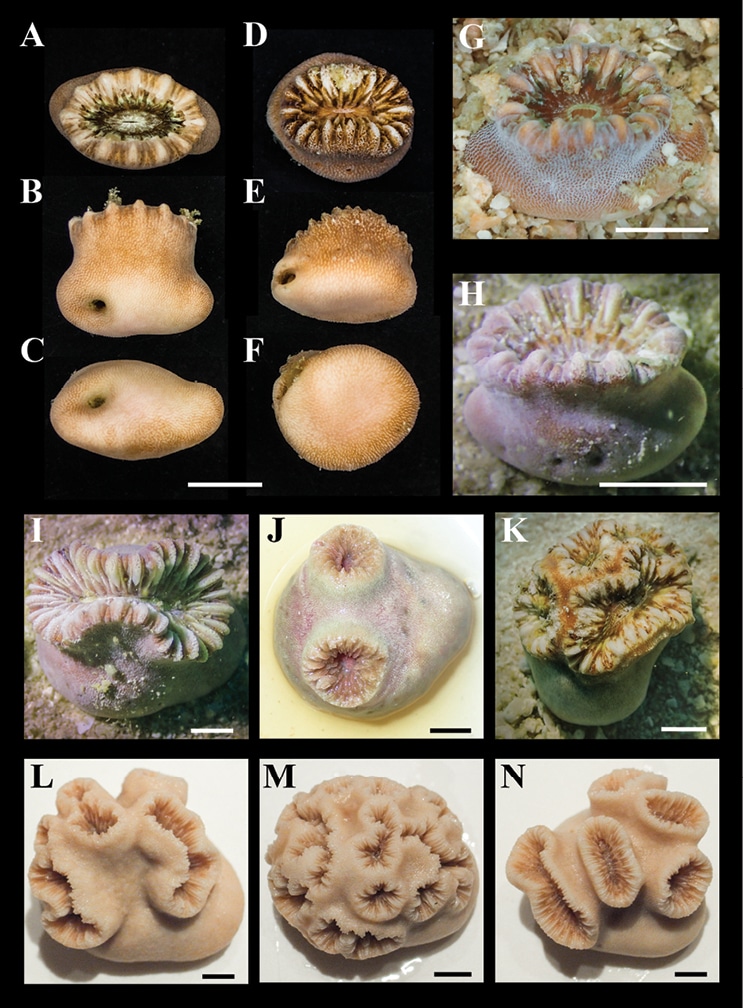

A New Look at the Family Dendrophylliidae
Dendrophylliidae is the third most diverse family of hard corals, with around 183 species. They are an Indo-Pacific group of the order Scleractina but are often non-reef building and azooxanthellate. To date, they have been classified primarily for their apparent morphological features, recently proven in other groups of corals to be quite unreliable and in need of revision.
This last month, Dr. Rahul Mehrotra and several other members and friends of Conservation Diver published a paper in the journal Contributions to Zoology that used DNA testing and high-resolution micro CT scans to propose a new phylogenetic hypothesis of the group. The paper led to many new and interesting findings about an already exciting family of corals, as we will explore here.
Heteropsammia: AKA the “Walking Dendro”
The first coral genera we have to discuss is, of course, Heteropsammia ("Hetero-" from the Greek ἕτερος (héteros) meaning "different" or "other," and "psammia" from the Greek ψάμμος (psámmos), "sand"). This small, inconspicuous coral forms a symbiosis with both a sipunculid worm (peanut worm) and a parasitic mussel. This worm helps it move around the soft bottom areas it inhabits and avoid being buried by sediment, forming an obligate mutualistic relationship. But how does this relationship even start?

According to Corals of the World, the coral larvae settle on a microgastropod shell out in the silt off the reef. Then, it forms an “obligate commensal relationship” with the worm (Aspidosiphon corallicola) as well as the mussel (Lithophaga lessepsiana), who lives directly above the worm. This is a fascinating observation, but it leaves so many obvious and burning questions completely unanswered. How does this relationship even start? Who links up with whom? Does the coral settle on the worm, or does the worm burrow into the coral? And when does the mussel move in to join this odd couple?
I reached out to Dr. Mehrotra, who explained it further. He said larvae of Heteropsammia settle only on the gastropod shell, and as the coral grows, the shell is left poking out of the side of the juvenile coral. Next, as nobody has confirmed it, he suspects that the worm moves into the shell and takes up residence there. Because the coral larvae form aggregations, it’s likely the worm (which he pointed out is actually Aspidosiphon muelleri) is able to detect and reproduce in a way that facilitates this cycle to occur in mass. He also mentioned that the parasitic mollusk is not always present and was never present in the ones he looked at from the Gulf.
So, still a lot of answered questions there, and hopefully, an investigation that a future student will pick up. It would be fascinating to do spawning and development experiments with both the coral and the worm in our future coral-slug lab on a private Pacific island funded by curious billionaires.
What else was learned about Heteropsammia?
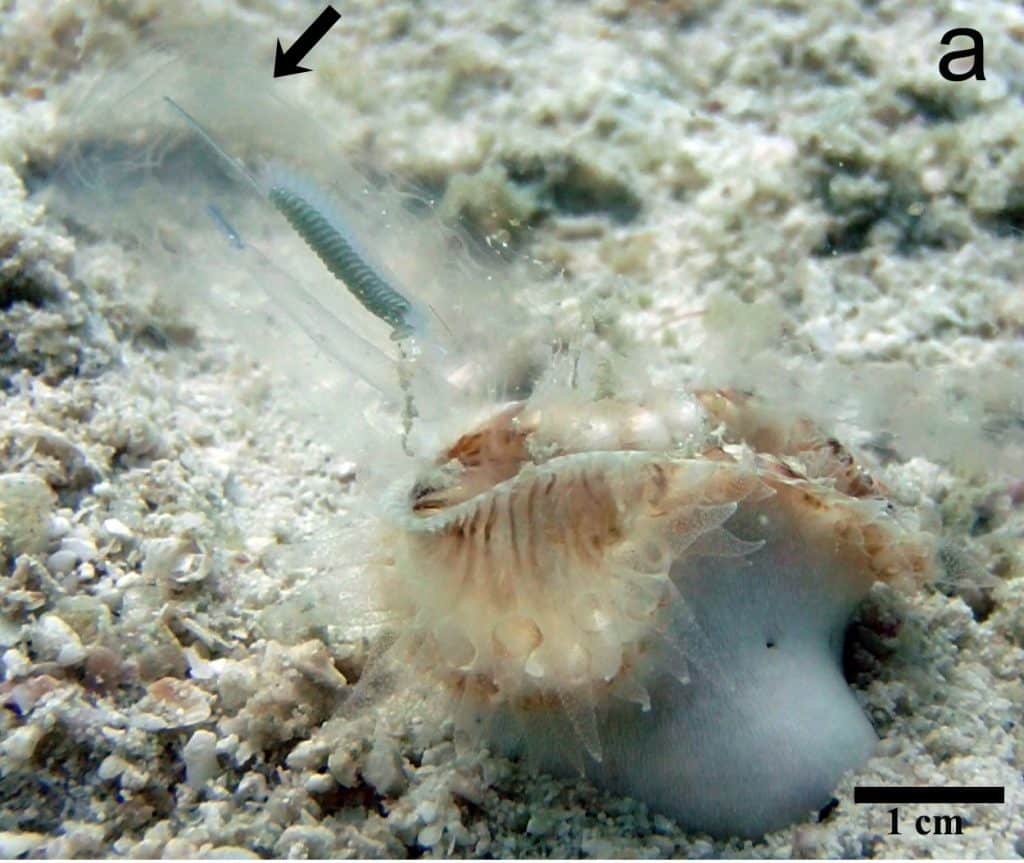
Heteropsammia is no stranger to our team. In 2015 we published how they consumed sea salps much larger than themselves, not with their tentacles, but instead by opening their mouth really wide and using their digestive filaments (new horror movie idea, anyone?). Then, in 2019, we included them in our feeding trial paper investigating heterotrophy in corals and their ability to eat sea slugs (this time having some manners and using their tentacles).
This new paper not only helps to reorganize the species within Heteropsammia more accurately, it also made several new mind-blowing observations. First, in addition to hosting the sipunculid, one coral also was found to host a comfy little hermit crab in the worm’s burrow (a first for Koh Tao), and another was found to be hosting a beautiful but parasitic epitoniid snail (think Wentletrap). It also added several new items to the ‘list of things we have seen them eat,’ including more sea slugs (rest in peace Costasiella), an anemone, and even a whole jellyfish. Wow.

Tubastrea: the world traveler
Tubastraea ("Tuba" from the Latin word for "tube" and "Astrea" from the Latinized form of the Greek "Astraea,” referring to star-like shapes) are known for their bright colors and huge corallites. They are conspicuous corals found throughout the Indo-Pacific, often in areas with poor light (overhangs, caves, turbid waters, etc.). They can grow to incredible sizes, but their azooxanthellate nature means their skeleton is thin and brittle, often not contributing to reef growth.

Feeling a bit of wanderlust, two species of Tubastraea (T. coccinea and T. tagusensis) stowed away in the bilge water of a boat traveling through the Panama Canal in the early 1980s. Since then, they have successfully colonized this new ocean, setting up along more than 3,500 km of coastline in the Atlantic and Caribbean. According to genetic analysis, the word is out, and several more migrations have occurred since the first pioneers made their way over. They now hold the record as the only Scleractinian with populations in both oceans.
As cosmopolitan as they are, there is still so much we don’t know about them and their habits. This new paper saw them doing strange things (while confirming or reclassifying many species). First, a colony was found cooperatively eating a sea pen (Pennatulacean), with two coral polyps holding down the sea pen while the third ate it. This is the first recorded observation of an Anthozoan eating another Anthozoan. The brutal gang behavior of Tubastrea must now be well known in the area, as the team did not find any parasites, predators, symbionts, or epibionts on the corals they observed.
Other findings from the ‘muck.’
Besides thoroughly examining the family Dendrophylliidae in the Gulf of Thailand, the paper highlights the overlooked soft-sediment, or muck, habitats. Recreational diving in the region is primarily confined to the near-shore fringing reefs or the scattered submerged pinnacles dotting the Gulf. As such, most of the attention has been placed there, and in the face of climate change, this is not unwarranted.
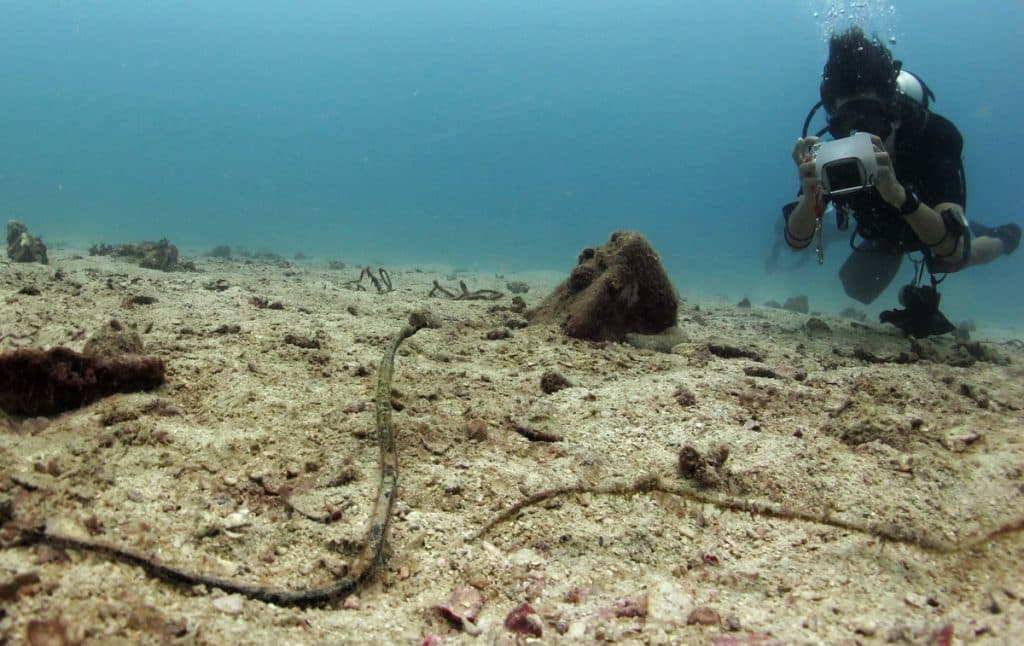
But, a largely unexplored and overlooked treasure trove of biodiversity exists in the muddy plains that comprise much of this ancient submerged basin. New and exciting organisms, relationships, feeding habits, and survival mechanisms await observation, pondering, and learning.
Based on observations from around the region, the team predicts that two more genera of Dendrophyllids are waiting to be found in the area. It is hoped that bringing attention to the natural riches of these areas will increase public demand for protection and help aid in their continued survival.
Please check out the full paper, Biodiversity, ecology, and taxonomy of sediment-dwelling Dendrophylliidae (Anthozoa, Scleractinia) in the Gulf of Thailand, by Rahul Mehrotra, Suchana Chavanich, Coline Monchanin, Suthep Jualaong, & Bert W. Hoeksema.
Sea Slug Diversity in Koh Tao, Thailand
An extensive 14-year study using benthic surveys and photographic records has revealed a stunning richness of sea slug diversity around the island of Koh Tao, Thailand. A staggering 191 distinct species across the orders Sacoglossa (14 species), Cephalaspidea (23 species), Aplysiida (5 species), Pleurobranchida (3 species), and Nudibranchia (146 species). Among these, seven species are the first of their kind reported in the Gulf of Thailand, while an additional 115 species represent the first records for Thailand as per current literature.
These findings have arisen through the dedication and hard work of many citizen science divers, enthusiasts, and local photographers under the direction of Dr. Rahul Mehrortra. Rahul worked for many years with the New Heaven Reef Conservation Program, was a founding board member of Conservation Diver, and then started his center, the Aow Thai Marine Ecology Center (ATMEC), in partnership with the Love Wildlife Foundation.
Over more than a decade, he has led many studies resulting in eight scientific publications to date:
- Predation on a sacoglossan gastropod by a mushroom coral. R Mehrotra, CM Scott, JM Rohrer, BW Hoeksema - Coral Reefs, 2015
- Species inventory of sea slugs (Gastropoda: Heterobranchia) for Koh Tao, Thailand, with 25 first records for Thai waters. R Mehrotra, CM Scott - Marine Biodiversity, 2016.
- On the genus Armina (Gastropoda: Heterobranchia: Nudibranchia) in Thailand. R Mehrotra, M Caballer Gutierrez, S Chavanich - Marine Biodiversity, 2017
- Selective consumption of sacoglossan sea slugs (Mollusca: Gastropoda) by scleractinian corals (Cnidaria: Anthozoa). R Mehrotra, C Monchanin, CM Scott, N Phongsuwan… - PLoS One, 2019
- The formerly enigmatic Unidentiidae in the limelight again: a new species of the genus Unidentia from Thailand (Gastropoda: Nudibranchia). T Korshunova, R Mehrotra, S Arnold, K Lundin… - Zootaxa, 2019
- A new species of coral-feeding nudibranch (Mollusca: Gastropoda) from the Gulf of Thailand. R Mehrotra, S Arnold, A Wang, S Chavanich… - Marine Biodiversity, 2020
- On the Plakobranchidae (Gastropoda, Sacoglossa) from soft sediment habitats of Koh Tao, Gulf of Thailand, with descriptions of two new species. R Mehrotra, MC Gutiérrez, CM Scott, S Arnold… - ZooKeys, 2020
- An updated inventory of sea slugs from Koh Tao, Thailand, with notes on their ecology and a dramatic biodiversity increase for Thai waters. R Mehrotra, MAC Gutiérrez, CM Scott, S Arnold… - ZooKeys, 2021

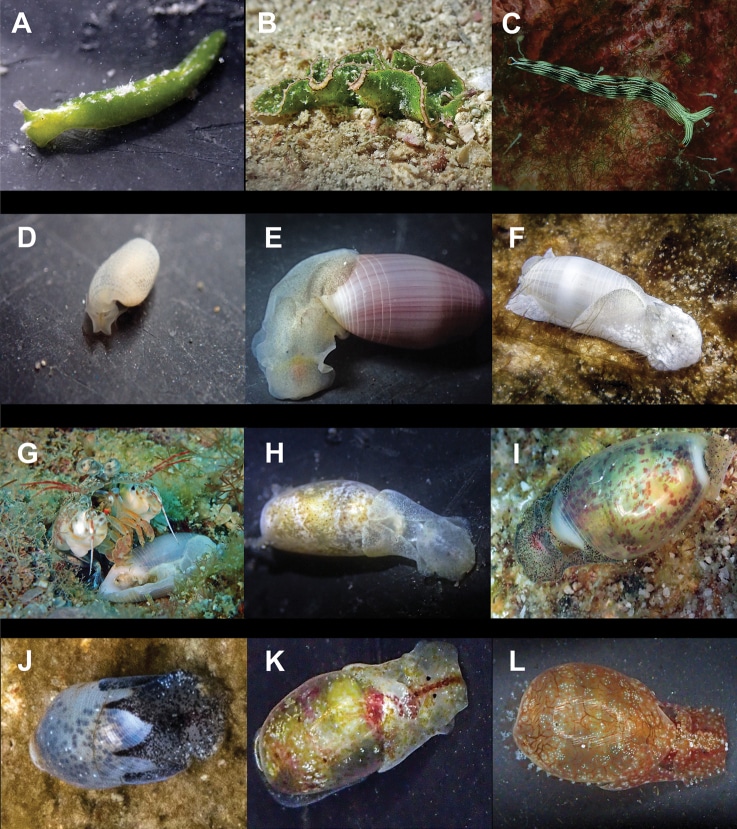

A Rich Biodiversity of sea slugs
The abundance of species diversity for an island of Koh Tao's size is unusually high. Yet, these studies have shown that most species were sighted infrequently and often had limited geographic ranges, highlighting the need for continued surveying and monitoring. Significantly, many species were discovered in non-reef areas, indicating that these regions harbor greater biodiversity than previously understood. This suggests the potential for promoting non-coral reef tourism, particularly as the local coral reefs face threats from overuse by SCUBA divers.
New Species Descriptions
In addition to the wider study of sea slug diversity, several focused studies were conducted. The Indo-Pacific genus Phestilla, which has been a subject of ongoing taxonomic debate, was re-evaluated. A previously unknown species of Phestilla was discovered feeding on Pavona explanulata, a coral species, in Koh Tao. This observation sparked a fresh discussion about this genus's position, and the ecological implications of its coral-parasitic behavior.
Finally, the sea slug heterobranch fauna of Thailand, with a total of 191 species, has seen an intriguing development. Two new species of the genus Armina were discovered in Thailand, distinct from the only previously recorded Armina semperi. Armina scotti, and Armina occulta. are described in detail, highlighting their unique morphological features and contributing to our understanding of the complex and diverse world of sea slugs.
New Understanding Of Trophic Functions
Another study unveiled the surprising revelation that some reef corals consume sea slugs. The feeding trials involved six species of sacoglossan sea slugs and four species of solitary corals. The results showed significant differences in both the time of ingestion and consumption state among the different sea slug species. Prey size was a crucial factor, with larger prey being ingested more slowly and rarely than smaller ones. This study paves the way for a deeper understanding of coral diet, highlighting the significant differences between opportunistic prey capture and actual predation events.
A Diverse Hot-spot for Sea Slugs
These studies shed light on the overlooked richness of marine biodiversity in non-reef areas and underscore the importance of continuous exploration and research in understanding and preserving marine life around Koh Tao and beyond. The constant evolution of taxonomy and species reclassification demands consistent monitoring and updated records, thereby setting the stage for a more comprehensive and accurate understanding of marine biodiversity.
Proactive & Reactive Ecosystem Restoration
Proactive and reactive ecosystem restoration are two new terms that more accurately define what is actually happening in the real world. They are replacing the old terms of passive and active ecosystem restoration. The two modes were broadly defined in terms of where the human energy and resources were put in the hopes of bringing back ecosystem health and function.
In passive restoration, the energy was put into stopping the threat and letting the ecosystem recover independently. In active restoration, our energy and resources assisted or facilitated the ecosystem's recovery more directly. These terms were always a bit ambiguous and poorly conveyed the nuance and complexity of the actions being performed by managers.
In a new paper by Hein et al., 2021, the authors discuss this issue and propose using new terms to describe these two restoration branches as they pertain to coral reefs. They introduce the term ‘proactive’ to replace passive, and ‘reactive’ to replace active restoration. These terms more accurately describe the actions being taken and may make communicating the details of these projects more precise and relatable. We at Conservation Diver will be switching up our terminology in support of this, and here is why we think you should too.
Passive and Active Coral Restoration
For decades, the prevailing opinion and policy of reef managers were that protection is always preferred over restoration. By stopping the threats to the ecosystem, the flora and fauna would rebound independently without further human intervention. From this came the term ‘passive restoration,’ meaning that no time, energy or resources were put into the ecosystem to return its health, diversity and function.
However, this term implies that nothing is being done when in fact stopping the threat is anything except “passive.”

For example, Tanote Bay on the island of Koh Tao, Thailand, was one of the more beautiful and vibrant reefs in the entire region. In 2006, the municipal government constructed a large reservoir above the bay to address the island’s unstable freshwater resources.
This was accomplished through massive deforestation, road cutting, and digging on the highest peak in the bay's watershed. By 2008, millions of tons of sand and clay had been washed into the bay, burying the reef under 1-2 meters of sediment. The coral reef was literally gone, and the water quality was extremely poor as more sediment loaded the area with each rain.
In 2008, we worked with the New Heaven Reef Conservation Program, the Save Koh Tao Community Group, and many community volunteers to ‘passively’ restore the bay by stopping erosion and sedimentation.
This included planting hundreds of thousands of Vetiver grass tillers and trees; constructing over a hundred check dams, and installing hundreds of erosion control logs and blankets: all of which took more than three years. In our minds, it was anything except passive, as the word is used in everyday language. However, since we were not working in the coral reef itself, that was how it was defined.

In the same way, the word ‘active restoration’ never really encompassed what managers were doing or moving towards in their techniques and methods. As Hein et al. point out: in the past, restoration was thought of as the act of bringing the ecosystem back to its historical state. However, bringing ecosystems back to their historical state will not be possible in the face of the increased effects of climate change.
Instead, the focus must shift from maintaining historical species to maintaining the “key ecosystem processes, functions, and services through the next few decades of climate change.”
Proactive and Reactive Ecosystem Restoration
The authors (Hein et al., 2021) propose the two new terms as a way to clarify the actions being done and the intent behind them in the context of a rapidly changing planet.
Proactive restoration would thus refer to any act or initiative aimed at “protecting and enabling recovery.” These proactive measures then go on to support the reactive measures “aimed at repairing ecosystem function and assisting the recovery of a degraded reef system, should it not be able to recover on its own.”
With this new, more accurate terminology, the things we do to protect the ecosystem (such as erosion control, wastewater treatment, and mooring buoy installations) are considered proactive measures. These are things done primarily on adjacent ecosystems to help facilitate recovery within the target ecosystem.
In some cases, like when there is still available structure and high larval supply, this can be all that is required to return the ecosystem services and function. And even in situations where those factors are not present, it is still the prerequisite for most successful reactive projects down the line.
Reactive projects in coral restoration would include coral gardening, artificial reefs, larval culturing, and all the other projects reef managers implement as part of a successful holistic program. These are the actions taken to increase the health, abundance, and diversity of key reef species or improve their resilience and help them adapt to changing conditions. The authors of the report developed this graphic to help visualize the actions taken under each mode of coral restoration:
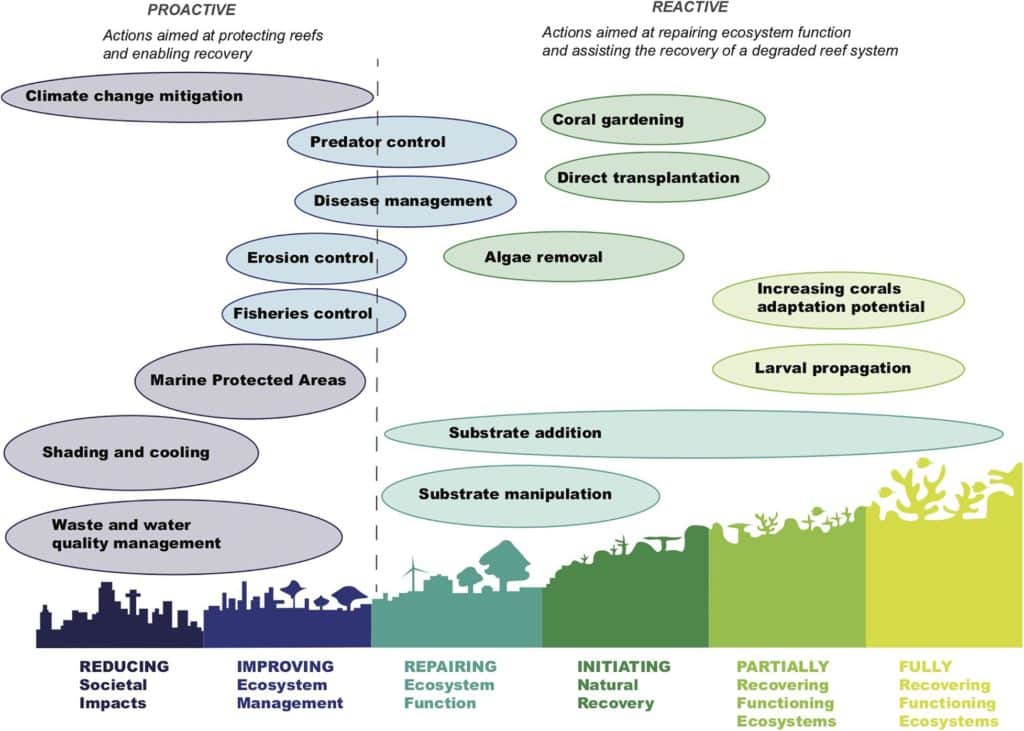
The coral restoration industry is still in its infancy but is one that is becoming more urgently necessary with reefs around the world in rapid decline.
While we work to solve the issues leading to climate change, we must be proactive and reactive in our efforts to preserve ecosystem value and function. These new terms help to show not only the effort and planning that has to go into what was once called passive restoration but also open up what was active restoration to include the work being done to build resilience and assist in the adaptation of corals through breeding programs. This is only one minor point that this vital report brought up, so stay tuned as we dive deeper into its recommendations and implications.
Understanding Corallivorous Drupella Snails
Although outbreaks of corallivorous Drupella snails have been increasing across the Indo-Pacific since the 1980s, still very little is known about their reproductive ecology. These tiny snails can occur in great abundance and can contribute to reef decline by lowering the total abundance of living coral and changing the population structure of reef communities.

Tracking these Coral Predators
Conservation Diver has been focusing on Drupellas for some time, with our first observation of the snails shifting their preferred food sources following the global mass coral bleaching event of 2010. Since then, our partners at the New Heaven Reef Conservation Program have collected more than 179,740 Drupella snails from around the island of Koh Tao, with 76% coming from a single bay.
In 2019, a team of our Conservation Diver Trainers traveled to Mauritius for a collaborative research expedition with the University of Mauritius. They were pleased to apply their Drupella snail knowledge to the local reefs and assist published Drupella snail researcher Deepeeka Kaullysing, in recording observations from the area. During their biodiversity surveys, primarily focused on heterobranchs, they noticed a significant deposition of egg masses under mushroom corals in the vicinity of a large Drupella aggregation. Upon closer inspection, they realized they were looking at the largest concentration of Drupella egg clusters ever recorded.
Although the first outbreak of Drupella snails was recorded in the early 1980s, much of what we understand about their life history is derived from similar organisms. Very few publications detail observations of the egg or larval stage of these predators, which is vital to know to mitigate the damage caused by over-populations or outbreaks.
Understanding Drupella Lifecycles
The first recorded Drupella egg deposition was published by Sam et al. in 2016 in an aquarium. This was followed quickly by the first in situ observation in 2017 by Scott et al. and was also the first record of egg deposition on the underside of Fungiidae corals.

The recent Kaullysing et al. (2020) publication is the first record of Drupella egg deposition in Mauritius and the Western Indian Ocean. Additionally, this is the first record of in situ egg deposition on corals other than Fungia. This time, eggs were observed on Fungia, Montipora, and the shell of another Drupella snail.
Furthermore, it represents the highest abundance of corallivorous Drupella eggs ever observed, with 5,020 egg bundles on a single coral (each bundle contained approximately 96 embryos).
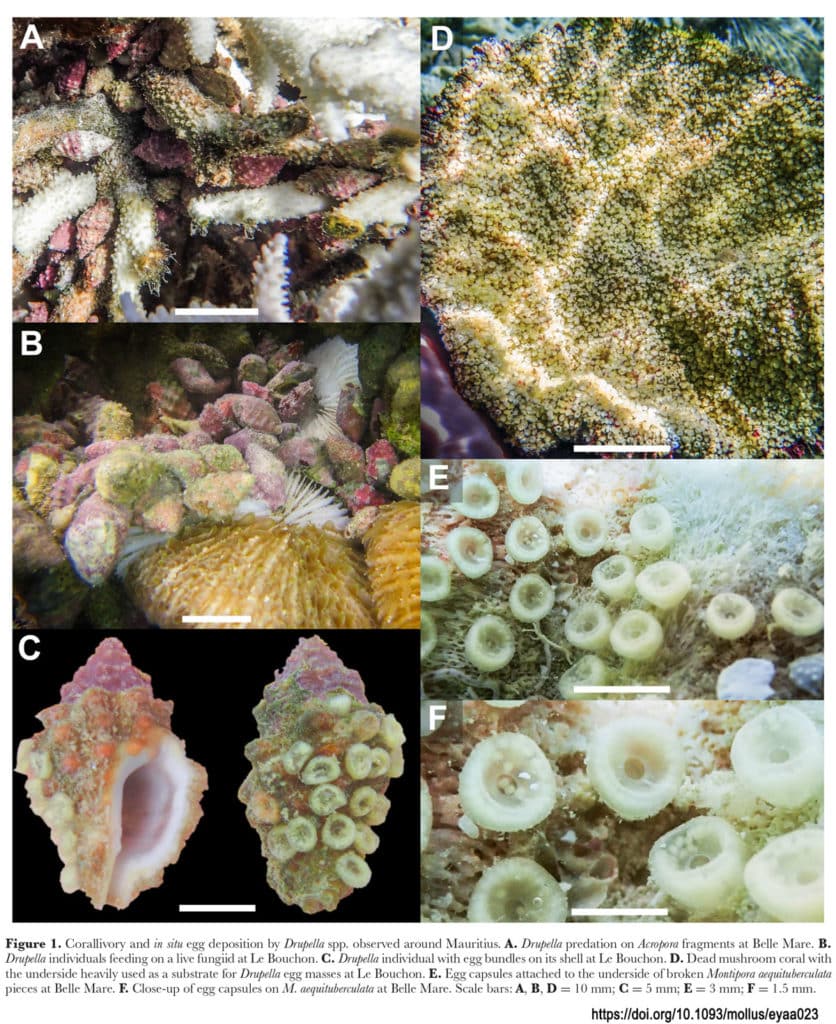
Observations such as these are vital to the understanding of the ecology and life history of these cryptic species. Only 40 years ago, they were essentially unheard of, yet today they are seen as one of the Indo-Pacific's significant problematic coral predators.
Stopping Outbreaks of Drupella
To halt outbreaks and mitigate their damage, reef managers must understand the details of their life history. By targeting benthic egg cases for removal rather than the adults, much time and resources could be saved.
The program on Koh Tao has been working for a decade to remove nearly 180,000 adult snails, whereas removing just the observed corals in Mauritius could potentially prevent the dispersal of 1.6 million embryos (4 corals x 5,000 egg bundles each x 80 embryos per egg bundle).
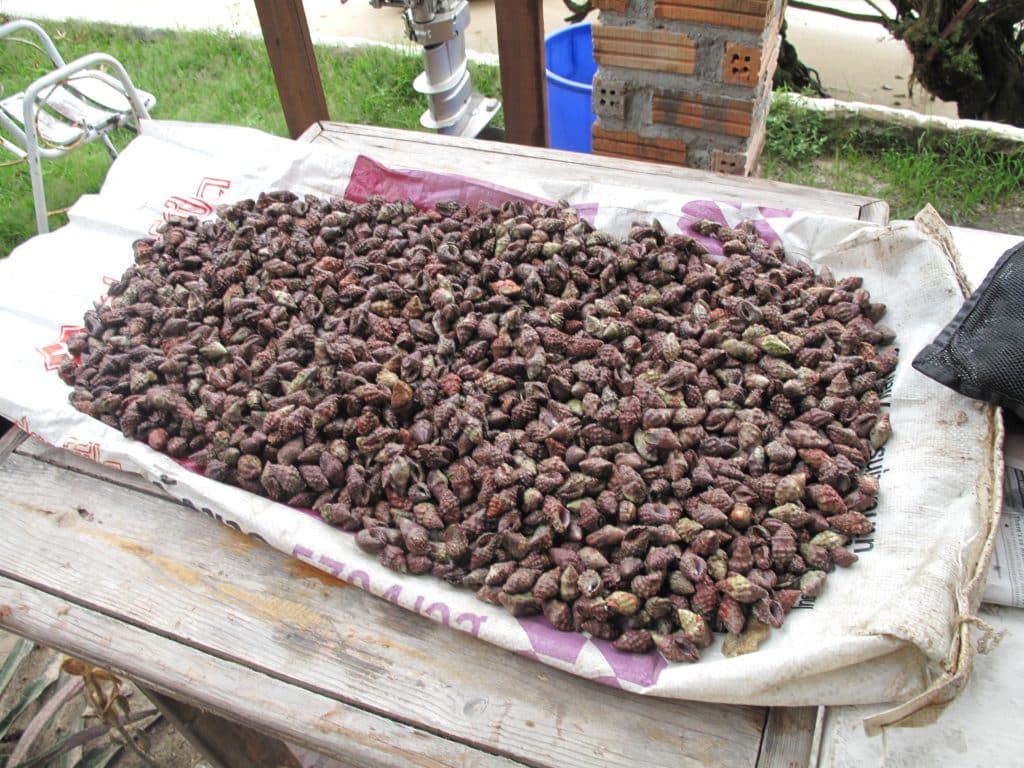
This is a very important publication for the advancement of this field and surely will be one of the stones placed on the path to better understanding and management guidelines for these pervasive coral predators. We wish our sincerest gratitude and congratulations to all of the authors, but especially those on the Conservation Diver team; Rahul Mehrotra, Spencer Arnold, Alyssa Allchurch, and Elouise Haskin.
Be sure to check out the paper here
A New Record of Heliopora Coral
Until recently, it was thought that the genus Heliopora was monotypic, with the only species described as Heliopora coerulea. However, that is quickly changing, and the Conservation Diver team is helping to increase records around the Indo-Pacific. Our finding represents the second hermatypic octocoral we have discovered in previously unknown locations, after Pau Urgell found the very rare coral Nanipora on Koh Tao in 2014.

A Reef-Building Soft Coral
Heliopora is an octocoral (mostly soft, non-reef building) however it is hermatypic, meaning that it is a reef builder. This genus is unique in that the skeleton has a blue coloration derived from the iron salts in its fibrous aragonite matrix.
This species can be traced back more than 120 million years to the Cretaceous Era and has remained mostly unchanged since. It was only in 2018 that the first records of a second species of Heliopora (H. hiberniana) was described, and only from 3 locations in Western Australia. But even then, it was hypothesized that this cryptic species could be more widespread.
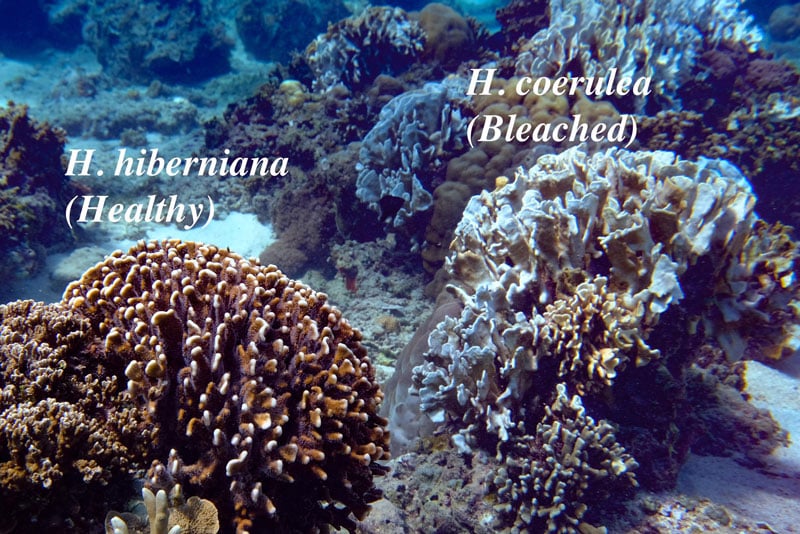
Whilst working on coral nurseries in the Maldives, Conservation Diver Board Member and head of Conservation Diver Indonesia, Leon Haines noticed a Heliopora colony that did not match any seen in the guide books.
After a quick online search, he stumbled upon the newly described species and contacted the scientists with a photo to confirm his suspicions. Indeed, it was a colony of H. hiberniana over 6000 km from the area it was originally described to science!
After his time in the Maldives, Leon returned to Indonesia where he subsequently noticed H. hiberniana to actually be one of the most common reef-building corals in the Gili Islands! After working with other researchers, he published the first record of H. hiberniana outside of Australia, this time both in the Baa Atoll, Maldives, and the Gili Islands of Indonesia.
Heliopora on Future Reefs
This is a significant find, as in the future, non-scleractinian hermatypic corals may be forced to play a more prominent role in sustaining the structure of coral reefs around the globe.
These octocorals seem to be less susceptible to warming climates and coral bleaching events and may provide an alternative structure to the historic hard coral species which built them. These records are also vital to tracking the effects of climate change as the historic home ranges of various species are altered due to changing ocean conditions and can help us to predict where conservation and protection efforts will be the most effective.
We extend our sincerest congratulations to Leon for this publication and are excited to see how we can contribute to the development of the understanding of this species in the future.
Mineral Accretion Technology
Mineral Accretion Technology Basics & Techniques

The Mineral Accretion Technology Basics & Techniques Course is designed to give students an introduction to the impacts of climate change on coral reefs around the planet, and also on tools that can be used to protect corals in the face of bleaching events. The course teaches students the basics of ocean chemistry, sea water electrolysis, and the construction/maintenance of low-voltage mineral accretion devices.
Prerequisites
- Be 12 years of age or older
- Be certified as an Advanced diver under a leading diving organization (PADI, SSI, RAID, etc) or an Open Water diver who has satisfactorily completed a buoyancy appraisal with a professional diver
- Demonstrate proper diving ability at an advanced Level and be proficient in buoyancy and self-awareness
- Be certified in our Ecological Monitoring Program and the Artificial Reef Theory and Techniques courses
Standards
- Understand the global effects of climate change on coral reefs
- Understand various techniques utilized by reef managers to manage reefs in the face of climate change
- Learn about ocean chemistry and the relationship between ocean pH and reef growth
- Learn about low voltage sea water electrolysis, and the benefits such technology can have for coral restoration and protection projects
- Learn how to construct and maintain a mineral accretion device
- Practice coral restoration and site maintenancen at a mineral accretion device artificial reef
Requirements
- Attend the lecture on climate change impacts to coral reefs, and mineral accretion devices
- Visit a mineral accretion device for data collection, monitoring, and maintenance
- Complete and pass the written exam
Expected course time about 9 hours
Certification Card
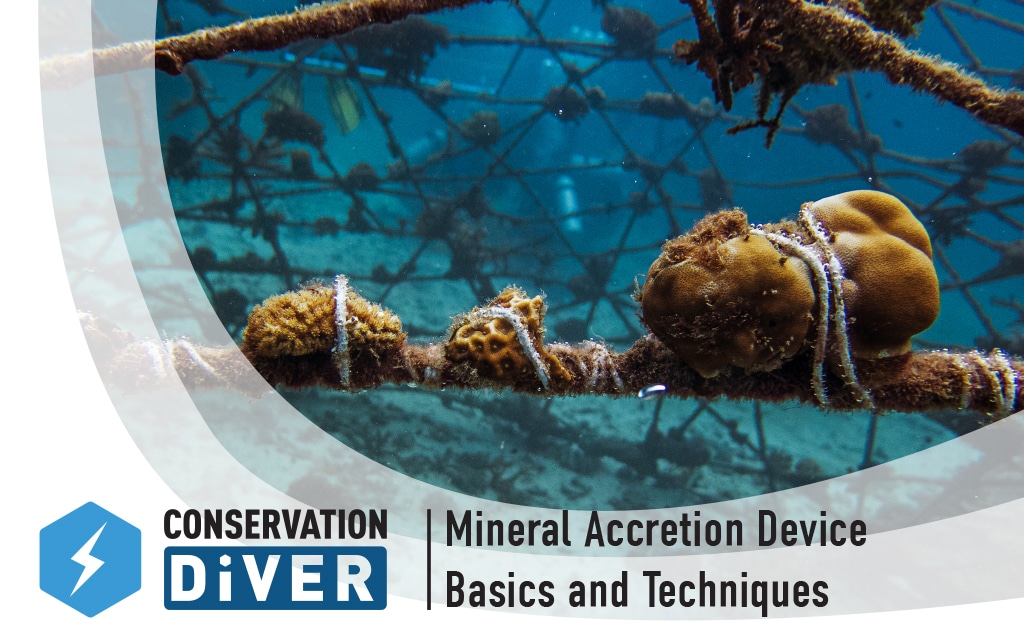
Training Centers
George Bevan
George is a Conservation Diver instructor and board member, he is also the owner of Azul Conservation in Nicaragua
Leon Haines
Leon Haines is a Conservation Diver Instructor and the director of Conservation Diver Indonesia at Blue Marlin Gili Air
Kirsty Magson
Kirsty is certified to teach all of the courses offered by Conservation Diver. Kirsty has been a Conservation Diver Trainer since 2015, and offers courses in English.

